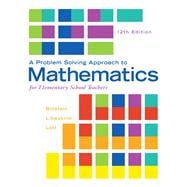NOTE: You are purchasing a standalone product; MyMathLab does not come packaged with this content. If you would like to purchase both the physical text and MyMathLab search for ISBN-10: 0321990595/ISBN-13: 9780321990594 . That package includes ISBN-10: 0321431308/ISBN-13: 9780321431301, ISBN-10: 0321654064/ISBN-13: 9780321654069 and ISBN-10: 0321987292//ISBN-13: 9780321987297 .
For courses in mathematics for elementary teachers.
The Gold Standard for the New Standards
A Problem Solving Approach to Mathematics for Elementary School Teachers has always reflected the content and processes set forth in today’s new state mathematics standards and the Common Core State Standards (CCSS). In the Twelfth Edition, the authors have further tightened the connections to the CCSS and made them more explicit. This text not only helps students learn the math by promoting active learning and developing skills and concepts—it also provides an invaluable reference to future teachers by including professional development features and discussions of today’s standards.
Also available with MyMathLab
MyMathLab is an online homework, tutorial, and assessment program designed to work with this text to engage students and improve results. MyMathLab includes assignable algorithmic exercises, the complete eBook, tutorial and classroom videos, eManipulatives, tools to personalize learning, and more.
| | | | |
| |
| | | | |
| |








